
Forward searchlight on platform
photo courtesy of Wilfrid Russell Grimwade collection,
University of Melbourne Archives, Image ID:3029
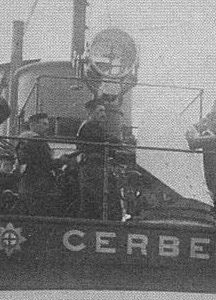
Aft searchlight on charthouse.
The first pair of searchlights were fitted to Cerberus in 1879.
"The Governor of Victoria has received a letter from the Agent General stating that he had shipped an electric light for the use of the Cerberus & six 6-inch Armstrong guns for the Nelson." Otago Witness, 1 March 1879
"The light produced is very weak, being only 5,000 candle-power, as compared with those of the gunboats, which are 12,500 candle-power." Victorian Naval Forces - Torpedo Manual, Whitehead Torpedoes 1889
| ||||||||||||||||||||||||||||||||||||||||||||||||||||||
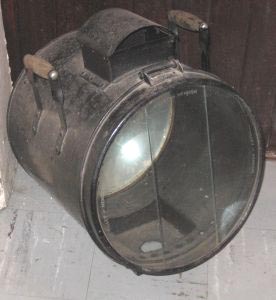
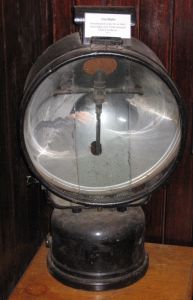
All evidence suggests that these lights were originally fitted at each end of the flying deck. In 1890 Nordenfelt 6 pounder QF guns were fitted at each end of the flying deck. To make room for these the aft searchlight was moved onto the charthouse. The forward searchlight was placed on a platform. Most likely the new searchlights were accompanied by the more powerful Alcock dynamo.
 Forward searchlight on platform photo courtesy of Wilfrid Russell Grimwade collection, University of Melbourne Archives, Image ID:3029 |  Aft searchlight on charthouse. |
Preparations were then made for the electric light, and shortly after seven o'clock last night the Cliff was brilliantly illuminated. The light was shifted into different positions, and had a very pleasing effect. Persons could be distinctly seen from the Cerberus as they walked on the shore and principal streets of Queenscliff. Throwing the light to the Victoria and the vessels anchored, hearty cheers were given by those on board for the display.

The dynamo machine used was one belonging to the Railway department; and although the effect was very good, it only gave those who were in charge of the lamp, an idea of what the light would be like if the Wilde machine belonging to the Cerberus could be used. |
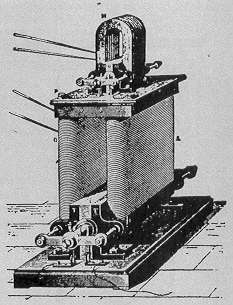 Wilde Generator. image courtesy of Tommy's History of Western Technology |
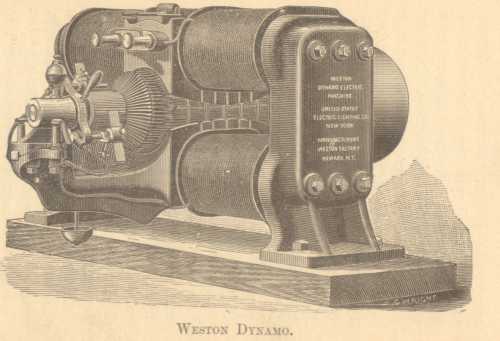
Re-positioning of Pumps & Addition of SpindlesThe Downton pumps (wheel like objects) were moved from under the ladderways (below) to the outside wall of the officer's toilets (right bottom) possibly during the 1879 refit. Most likely this was to allow their manual operation, using spindles (cranks) when docked.(right) These pumps were also used to supply water for fire fighting when the boilers were not lit. | 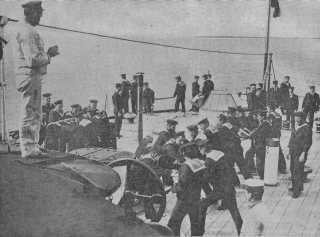 Fire Stations The Australasian, 28 May 1898 photo sponsored by Robert Lawson |
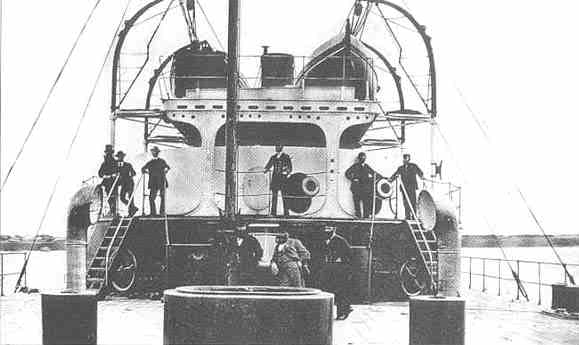 With pumps under ladderways in the 1870's. |
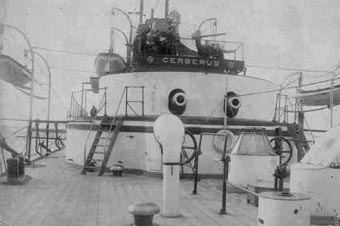 Position of pumps in the 1890's. photo courtesy of Peter Baxter |
Addition of Military MastIn 1879 the twin signaling Pole Mast configuration (right) was replaced with a single iron "Military Mast" with "Fighting Top". The stated purpose of the Fighting Top was to serve as a look-out & position for a searchlight & gattling gun. However it would seem that it was not used for the the searchlights as these were located at both ends of the Flying Deck. So too were the Nordenfelt "machine guns"(below). The Fighting Top was later lowered so it sat just above the vent on the Flying Deck. (below right, also note the Conning Tower to its left) |
 |
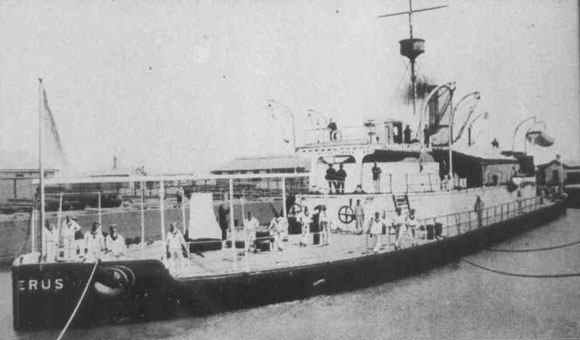 photo courtesy of Brian Hutchins Real Estate Agency, Black Rock. |
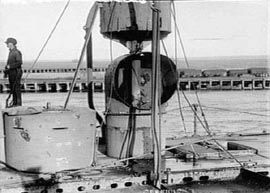 |
Colour SchemesThere appears to have been 5 colour schemes for Cerberus.
|
EmblemsSometime during 1898 the emblem on the ends of the flying deck was changed from a star to a coronet. Presumably this was done when Cerberus replaced Nelson as the flagship of the Victorian Navy.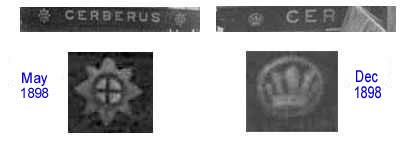 |
Ventilation & Lighting
"A convenience, which has been very much appreciated by those on board, is the illumination of the ship with electric-light. Hitherto kerosene lamps and lanterns have had to be used in the cabins and the forecastle [crew quarters], although there was electrical apparatus for the search-lights.
….Recently it occurred to the officers that there was no reason why a spare dynamo should not be utilised for the regular lighting of the ship…. ....the necessary insulations and switches were made by the naval artificers."The Argus, April 19 1897
"By those whose duty it is to pay only an annual visit to the Cerberus it was seen that great improvements in lighting & ventilation had been effected since last year. The ward-room has been enlarged, but it is in the men's quarters that the best work has been done. The improvements were carried out by the fleet engineer Mr. Breaks."The Argus, April 11 1898
Improvements to the Watertight Doors
"Another simple but very valuable contrivance has been utilised for closing the large iron doors connecting the various watertight compartments of which the vessel is composed. Formerly, in the event of a shot going through any portion of the vessel below the waterline, it was necessary to send men on deck to close the doors of the adjoining compartments, in order to prevent the water obtaining access to them. The cranks by which they were composed were all in exposed positions on the upper deck, and with an enemy in close quarters, concentrating the fire of a body of riflemen on these points, it would be possible to prevent the work being carried out with sufficient celerity to save the vessel from foundering. This would have exposed those operating the cranks in a battle situation. This was an evident defect, and was remedied by adding to the crank a very simple apparatus, by means of which the huge waterproof doors can be closed from the shield deck. Now it can be truly said that the vessel can be worked in action without a single man being exposed to the fire of the enemy."
The Argus, 10 May 1882The Notebook of Captain Thomas gives the location of all 26 watertight doors and states that they can be operated from the upper and lower decks.